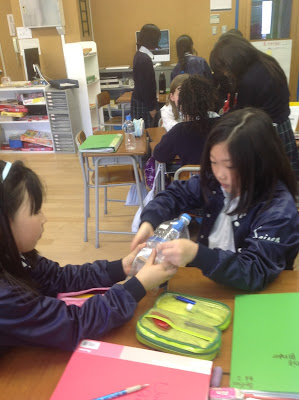We encourage students to make connections between units of inquiry from this year and to previous years. Earlier this year, fourth graders studied energy. Their knowledge of energy came in handy when inquiring into the function of the human body, because movement is a form of energy.
Fourth graders know that the muscular system and the skeletal system work together so we can make voluntary movements. They also know that muscles cause other movement in the body. For example, the heart, a muscle, pumps our blood. Muscles also move food through the digestive system.
Our models of the respiratory system demonstrate something amazing. How do we breathe? How does air move into our bodies? Muscles aren't pushing it like the heart pushes blood. Air doesn't just fall into us!
Here are pictures of the girls constructing and observing the models. The top of a plastic bottle represents the chest, the balloon represents the lungs, and a ziplock bag represents the diaphragm, a muscle.
Making the models is one thing. Using the models to reflect on the function of the respiratory system is more difficult.
Here is what Ayane wrote: "When the diaphragm gets smaller, there isn't enough space to keep the air so the balloon's (lung's) air gets forced out."
Here is what Tanatswa wrote: "When the diaphragm contracts the balloon releases air out but when it relaxes the air goes back inside."







No comments:
Post a Comment